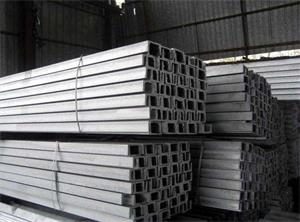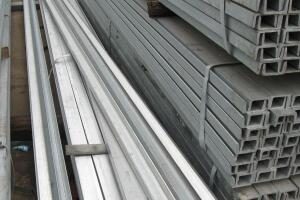Galvanized channel steel is an effective metal corrosion protection method and is mainly used in metal structure facilities in various industries.

Overview
Hot-dip galvanizing channel steel can be divided into hot-dip galvanizing channel steel and hot-dip galvanizing channel steel according to different galvanizing processes. The rust-removed steel piece is immersed in zinc liquid melted at about 440~460 °C to make steel. The surface of the component is adhered to the zinc layer to protect the surface.
Hot dip galvanizing is a very excellent one among various coating methods for protecting a steel substrate.
It is not only plated with a thick layer of pure zinc on steel, but also a layer of zinc-iron alloy after a relatively complicated physical and chemical action in the state of zinc being liquid.
This plating method not only has the corrosion resistance characteristics of electrogalvanizing, but also has a zinc-iron alloy layer. It also has strong corrosion resistance that cannot be compared with electro-galvanized. Therefore, this plating method is particularly suitable for use in various corrosive environments such as strong acid and alkali mist.
Principle
The hot-dip galvanizing layer is formed by zinc in a high-temperature liquid state in three steps:
1. The surface of the iron base is dissolved by the zinc liquid to form a zinc-iron alloy phase layer;
2. The zinc ions in the alloy layer further diffuse into the matrix to form a zinc-iron interdiffusion layer;
3. The surface of the alloy layer is covered with a zinc layer.
Process flow
Hot-dip galvanizing channel process:
Raw material inspection → pickling → cleaning → zinc assist → drying → galvanizing → cooling → passivation → cleaning → finished product inspection → inspection packaging.
According to the habits, the hot-dip galvanizing process is divided into two categories: off-line annealing and in-line annealing according to different pre-plating treatment methods.
1. Out-of-line annealing
Off-line annealing means that the hot-rolled or cold-rolled steel is first subjected to recrystallization annealing in a bottom-type annealing furnace or a bell-type annealing furnace before entering the hot-dip galvanizing line, so that the annealing process is not performed on the galvanizing line.
Steel must maintain a clean, pure iron active surface free of oxides and other contaminants prior to hot dip galvanizing. In this method, the annealed surface scale is first removed by pickling, and then coated with a solvent consisting of zinc chloride or a mixture of ammonium chloride and zinc chloride to prevent the steel from being oxidized .
(1) Wet hot-dip galvanizing
The solvent on the surface of the steel does not dry (ie, the surface is still wet) and enters the zinc solution whose surface is covered with a molten solvent for hot-dip galvanizing. The disadvantages of this method are:
a. Can only be galvanized in a lead-free state, the alloy layer of the coating is very thick and the adhesion is very bad;
b. The generated zinc slag is accumulated at the interface between the zinc liquid and the lead liquid and cannot be deposited at the bottom of the pot (because the specific gravity of the zinc slag is greater than that of the zinc liquid and less than the lead liquid), so that the steel contaminates the surface by passing through the zinc layer.
Therefore, wet hot dip galvanizing has been basically eliminated.
(2) Single steel
This method generally uses a hot rolled rolled sheet as a raw material. First, the annealed steel is sent to a pickling workshop, and the hot-dip galvanized iron sheet on the surface of the steel is removed with sulfuric acid or hydrochloric acid.
The steel after pickling is immediately immersed in a water tank for galvanizing, which prevents the steel from reoxidizing. After pickling, water washing, squeezing, drying, and entering the zinc pot (the temperature is always maintained at 445-465 ° C), hot-dip galvanizing, and then oiling and chromizing. The hot-dip galvanized sheet produced by this method has a significantly improved quality than the wet-galvanized product, and has a certain value only for small-scale production.
(3) Huilin Law
The continuous galvanizing production line includes a series of pre-treatment processes such as lye degreasing, hydrochloric acid pickling, water rinsing, solvent coating, drying, etc., and the original plate needs to be subjected to hood annealing before entering the galvanizing line.
This method has a complicated production process and high production cost. More importantly, the products produced by this method often have solvent defects and affect the corrosion resistance of the coating.
Moreover, the AL in the zinc pot often acts on the surface of the steel material to form aluminum trichloride and is consumed, and the adhesion of the plating layer is deteriorated. Therefore, although this method has been published for nearly 30 years, it has not been developed in the world hot-dip galvanizing industry.
2. In-line annealing
In-line annealing is to directly supply the coil as a hot-dip galvanized original plate by cold rolling or hot rolling, and perform gas protection recrystallization annealing in the hot-dip galvanizing line.
Hot-dip galvanizing methods belonging to this category include: Sendzimir Act, Modified Sendzimir Act, US Steel Law (with Kawasaki Act of Japan), Silas Act, Sharon Law.
(1) Sendzimir Law
It combines the annealing process and the hot-dip galvanizing process. The in-line annealing mainly consists of an oxidation furnace and a reduction furnace. The strip steel is directly heated to about 450 degrees in the oxidation furnace, and the residual rolling oil on the strip surface is burned off to purify the surface.
After that, the strip is heated to 700-800 degrees to complete the recrystallization annealing. After the cooling section is controlled, the temperature before entering the zinc pot is about 480 degrees. Finally, the zinc pot is galvanized without contact with the air. Therefore, the Senjimir method yields. High and good galvanizing quality, this method has been widely used.
(2) US Steel Law
It is a variant of the Sendzimir method, which simply replaces the degreasing of the oxidizer with an alkaline electrolytic degreasing tank, and the rest of the process is basically the same as the Sendzimir method.
After the original board enters the line, it is first electrolytically degreased, then washed, dried, and then recrystallized by a reducing furnace with a protective gas, and finally into the zinc pot by hot-dip galvanizing in the case of sealing.
In this method, since the strip steel is not heated by the oxidation furnace, the oxide film on the surface is thin, and the hydrogen content of the shielding gas in the reduction furnace can be appropriately reduced.
This is beneficial to furnace safety and reduced production costs. However, since the strip steel is not preheated, it enters the reduction furnace, which undoubtedly increases the heat load of the reduction furnace and affects the life of the furnace. Therefore, this method has not been widely used.
(3) Silas Act
Also known as direct flame heating method; firstly, the strip is eluted with alkali by alkali, and then the scale of the surface is removed with hydrochloric acid, washed with water, dried, and then passed into a vertical in-line annealing furnace directly heated by a gas flame, and the furnace is strictly controlled. The ratio of the gas to the air is so that the incomplete flame is burned in the case of excess gas and insufficient oxygen, thereby causing a reducing atmosphere in the furnace.
It is rapidly heated to a recrystallization temperature and the strip is cooled under a low hydrogen protective atmosphere, and finally immersed in a zinc liquid in a sealed state to perform hot dip galvanizing.
The method is compact, with low investment costs and high output (up to 50/hour). However, the production process is complicated, especially when the unit is stopped, in order to avoid burning the strip steel, it is necessary to adopt a method in which the furnace traverses away from the steel strip, so that there are many operational problems, so the hot-dip galvanizing industry adopts this method very little.
(4) Sharon Law
In 1939, Sharon Company of the United States put into production a new type of hot-dip galvanizing unit, so it is also called Sharon Law. This method is to inject a hydrogen chloride gas into the strip in an annealing furnace and bring the strip to a recrystallization temperature, so it is also called a gas pickling method.
Pickling with hydrogen chloride gas not only removes the scale on the surface of the strip, but also removes the grease on the surface of the strip. Since the surface of the strip is corroded by oxidizing gas to form a pockmark, the coating obtained by the Sharon method is adhered. Very good.
However, due to the serious corrosion of the equipment, it causes high equipment maintenance and renewal costs. Therefore, this method is rarely used.
(5) Improved Sendigmi
It is a more superior hot-dip galvanizing process; it connects the separate oxidation furnaces and reduction furnaces in the Sendzimir method from a smaller cross-section aisle, including preheating furnaces, reduction furnaces and cooling sections. The entire annealing furnace inside constitutes an organic whole.
Practice has proved that the law has many advantages: high quality, high yield, low consumption, safety and other advantages have gradually been recognized.
It has developed very fast. Almost all of the new lines have been used since 1965. In recent years, the old Sendzimir units have also been modified in this way.

Theoretical weight table(sizes):
|
Specification
|
Height
|
Leg width
|
Waist thickness
|
Heavy weight
|
|
|
5#
|
50
|
37
|
4.5
|
5.438
|
|
|
6.3#
|
63
|
40
|
4.8
|
6.634
|
|
|
8#
|
80
|
43
|
5
|
8.045
|
|
|
10#
|
100
|
48
|
5.3
|
10.007
|
|
|
12#
|
120
|
53
|
5.5
|
12.059
|
|
|
12.6#
|
126
|
53
|
5.5
|
12.318
|
|
|
14#a
|
140
|
58
|
6
|
14.535
|
|
|
14#b
|
140
|
60
|
8
|
16.733
|
|
|
16#a
|
160
|
63
|
6.5
|
17.24
|
|
|
16#b
|
160
|
65
|
8.5
|
19.752
|
|
|
18#a
|
180
|
68
|
7
|
20.174
|
|
|
18#b
|
180
|
70
|
9
|
23
|
|
|
20#a
|
200
|
73
|
7
|
22.637
|
|
|
20#b
|
200
|
75
|
9
|
25.777
|
|
|
22#a
|
220
|
77
|
7
|
24.999
|
|
|
22#b
|
220
|
79
|
9
|
28.453
|

Weight calculation
Calculation formula of channel steel (kg/m) W=0.00785 ×[hd+2t (b – d )+0.349 (R2 – r 2 )] h= high
b= leg length
d= waist thickness
t= average leg thickness
R= inner arc radius
r = end arc radius For example, find the weight per 100 m of channel steel of 80 mm × 43 mm × 5 mm.
From the catalogue of metallurgical products, it is found that the channel steel t is 8, R is 8 and r is 4 .
Then every m weight = 0.00785 × [80 × 5 + 2 × 8 × (43 – 5 ) + 0.349 × (82-4 2 )] = 8.04kg
Entry atlas